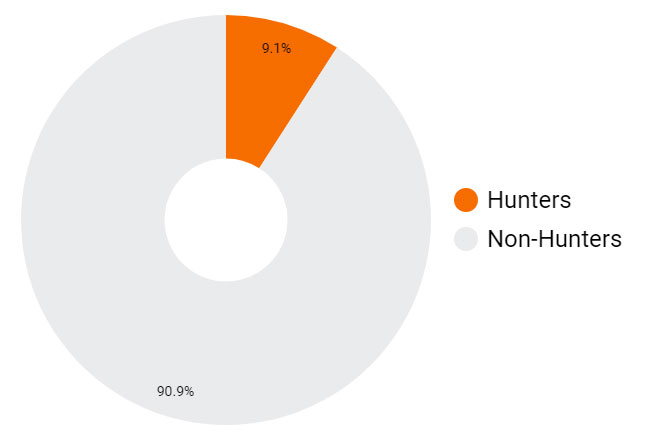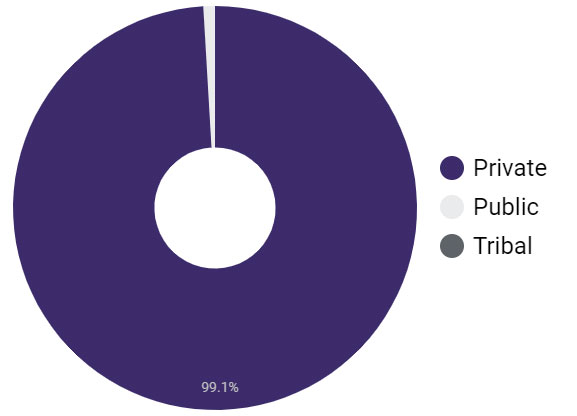Hunting in Kansas
Kansas Hunting at Glance
Kansas is a big-game paradise for deer, elk, and antelope hunters and it’s also known as one of the best states in the country for Upland Bird Hunting. Fortunately Kansas offers a lot of private land to hunt on, because securing a permit to hunt on the limited public lands can be difficult. Kansas does have a Walk In Hunting program (WIHA) that promises to give hunters better access, but it the quality of the land hasn’t been as good in recent years.
Learn more about Kansas Walk in Hunting.
The state’s deer population is among the largest in the US and some even say that Kansas has too many deer! Perhaps for this reason, the state allows hunters the harvesting of only one antlered deer per year, but numerous antlerless deer permits are usually available as a strategy to decrease the population.
Kansas ranks #17 in the nation for hunting licenses per capita and has a strong hunting culture with over 9% of the population classified as registered hunters.
Key Insights
- Kansas has a high number of hunting licenses per capital and a strong hunting culture.
- Most of the land in Kansas is private, with only a small percentage of land available for public hunting.
- Kansas offers a variety of hunting opportunities due to its diverse geography.
- The most popular small game animals to hunt in Kansas are pheasant, quail, dove, duck, and turkey.
- The most popular big game animals to hunt in Kansas are whitetail deer, mule deer, antelope, elk, and pronghorn, with whitetail deer being the most popular.
Table of Contents
| Population: | 2,937,880 |
|---|---|
| Hunters | 267,347 |
| Hunters % | 9.10% |
| Hunters Rank | 17 |

The state of Kansas is predominantly Private land and only 0.80% of the total acres could be considered huntable public land. In fact, Kansas ranks #48 overall in acres of public huntable land.

| Acres | % | Rank | |
|---|---|---|---|
| Total | 52,366,701 | ||
| Huntable Public | 420,000 | 0.80% | 48 |
| Private | 51,887,200 | 99.08% | 13 |
| Tribal | 7,200 | 0.01% | 27 |
Kansas ranks #1 for the percentage of private land and number 27 in terms of acres of tribal land in the country. Meaning that there is more privately owned land as a percentage of total acres than in any other state.
Kansas Hunting Seasons & Requirements
Explore Kansas Hunting Seasons.
For the most accurate information on Kansas Hunting Seasons, along with the state’s requirements for tag and bag limits, it’s a good idea to check with the Kansas DNR. We’ve provided their contact information below, along with links to helpful resources, including licensing.
Kansas DNR
512 SE 25th Ave.
Pratt, KS 67124
- (620) 672-5911
Helpful Links
Popular Game to Hunt in Kansas
Due to its varied geography, Kansas offers a rich variety of different hunting opportunities. In the hills and prairie you’ll find big game including deer, elk and pronghorn. Eastern Kansas has an abundance of small game, particularly waterfowl, and the Great Plains area is great for Upland birds and fowl.
Small Game Hunting in Kansas
Among small game hunters in Kansas, pheasant, quail, dove, duck and turkey are the most popular game animals. While all five of these species can be found throughout the state, they each have their own preferred habitat. Pheasants, for example, are typically found in agricultural areas with dense cover, while quail prefer more open grasslands. Duck hunting is often done in wetlands or along rivers, while turkeys can be found in both forested and open areas. Understanding the habitat preferences of each species can help hunters increase their chances of success. In addition, all five species are subject to different harvest regulations, so it is important to be familiar with the rules before heading out into the field. By taking the time to do some research, hunters can ensure a successful and enjoyable hunting trip.
Big Game Hunting in Kansas
According to the Kansas Department of Wildlife, Parks, and Tourism, the most popular big game animals to hunt in the state are whitetail deer, mule deer, antelope, elk, and pronghorn. Out of these five species,Whitetail deer are by far the most popular, with over 70% of hunters targeting them each year. Mule deer are the second most popular game animal, with just over 20% of hunters pursuing them. Antelope are the third most popular, followed by elk and pronghorn. While all five of these animals can be found in Kansas, each species has its own preferred habitat. Whitetail deer can be found in a variety of habitats, from woodlands to prairies. Mule deer are typically found in areas with a mix of grassland and brush, while antelope prefer open prairies. Elk are most commonly found in forested areas, while pronghorn inhabit open grasslands.
The hassle free way to monetize your acreage.
What are the best areas to hunt in Kansas?
Kansas offers hunting on both public and private land but be aware that a public hunting license can be difficult to get for non-residents. Fortunately there is also a lot of private land which offers opportunities for both small and big game.
Find Kansas Private Land Hunting by Map
Best places for Hunting Public Land in Kansas
As mentioned, if you only are able to hunt public land, you’ll be very restricted and less likely to have a good day out, but of the public options for hunting, Cheyenne Bottoms is a popular spot for hunting waterfowl, as it is home to a variety of species of ducks and geese. Cimarron National Grassland is popular for hunting deer, as the grassland provides ample cover for the animals. Flint Hills is popular for hunting turkey, as the hills provide good elevation for spotting the birds. Konza Prairie is popular for hunting quail, as the prairie is home to a large population of the birds. Tallgrass Prairie National Preserve is popular for hunting bison, as the preserve offers ample opportunity to view these majestic animals in their natural habitat.
1. Cheyenne Bottoms
2. Cimarron National Grassland
3. Flint Hills
4. Konza Prairie
5. Tallgrass Prairie National Preserve
Hunting Private Land in Kansas
With the large majority of land privately owned and some of the best hunting in the U.S. access to private land for hunting in Kansas is extremely appealing. When you hunt private land, it’s not only less crowded, the animals also tend to be less skittish and this means you’ll have a better day out in the field. Traditionally, accessing private land for hunting has been complicated and expensive. You either needed to join a club, hire a guide, or start knocking on doors.
Fortunately Wing It is simplifying this for hunters and outdoor enthusiasts of all types. Below are some of the properties available in Kansas or click through to our Explore page to start discovering huntable private land near you.